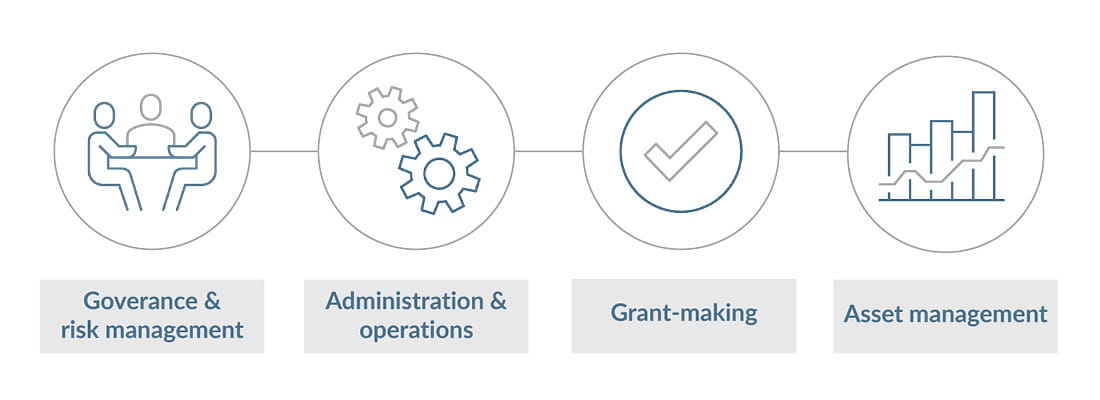Private family foundations are charitable entities set up by families to serve the public and bring about positive change in the community. In addition to their charitable goals, they can be an important tool to support stewardship of a family’s values and serve as a way to bring members together in a common enterprise. But they’re not without their complications. Confused about where to start? Begin by defining your strategy and outlining the goals — in detail — of your private foundation.
Define your strategy and vision
The first step in creating a successful private family foundation is defining a strategy and mission for the organization and its directors. Start by answering the following questions:
- Why is the foundation being created?
- How does it reflect the family’s core ideology?
- What are the defining values that will be carried out through the work of this foundation?
The process of creating an enterprise based on a family’s vision involves a similar set of questions to those considered when creating a family office or board structure for other entities.
Once the vision and values are defined, it’s time to roll up your sleeves and get working on the details — documentation, policies, who’s on the board, guidance for giving, and how the foundation’s assets will be invested. It can seem overwhelming at the outset, but the present and future needs of the foundation can be more easily understood by approaching the four key management pillars individually.

The four pillars of foundation management
1. Outline governance and risk management policies
This step establishes the “rules” of the foundation, including its structure, governing documents, board and officer responsibilities, policies, education of roles and responsibilities, and succession planning. It’s critically important to get this area right when the foundation is established and its governing documents are drawn up.
Governance and risk considerations take on increasing importance as the number of decision-makers increases. There’s typically less need for formality when there are fewer decision-makers, but as more individuals become involved in the foundation, additional policies are necessary to eliminate confusion, minimize conflict, and improve communication and processes.
A key factor when setting up your foundation will be choosing the entity type that best suits your circumstances — typically a trust or corporation. The best entity choice for you will depend on several factors:
- Is the priority control or flexibility?
- Is the intent for the foundation to go on in perpetuity or sunset at a predetermined date?
- Are there any unrelated business income tax considerations based on the assets funding the foundation? (Refer to “Factors to consider when creating your foundation: Corporation or trust?” for more insight on this topic.)
Next, you’ll determine who will serve as directors, officers, and trustees. Most individuals on family foundation boards come into the process with limited or no previous expertise. In this situation, it’s critical to properly orient the board to key terms, definitions, and best practices to set the new directors or trustees up for success. Questions inevitably arise about how spouses and children will participate. Consider asking these questions:
- Who will be able to serve and for how long?
- Does the family want to create a junior board with specific responsibilities?
- Will there be term limits and if so, to whom do they apply?
Once you have the basic structure of your private family foundation, it’s time to determine policies — both necessary and “nice to have” — to guide the foundation as it evolves over time. For example, every private foundation needs a conflict of interest policy as required by the IRS, but not every foundation needs a travel and expense policy. There may also be an overlap with policies already in place as part of a broader family office structure so it’s important to consider the application of those policies and how the foundation will comply.
2. Determine administration and operations requirements
This step covers details of administrative and operations requirements, including compliance, tax matters, cash management, custody of assets, check cutting, recordkeeping, and financial statements. These are the “T crossing” and “I dotting” activities that are often overshadowed by the less administrative aspects of managing a private foundation. Grant payments, estimated taxes, required annual state filings, and payroll and benefits (if applicable) also fall into this category. They’re essential items, but they can be delegated to technical and administrative support resources if family members lack the expertise or will to perform these tasks.
Tax compliance, including preparation of the annual 990pf, is also an important operational to-do. Foundation returns are completed by family CPAs or family offices as part of serving the family. This may be appropriate for smaller foundations but may not be the best choice for more complex or larger foundations where nonprofit tax expertise is required.
3. Set grant-making guidelines
Grant-making guidelines provide a roadmap for directors, establishing the rules for making, distributing, and administering grants, evaluation and progress reporting, communicating with charities, and overall stewardship of charitable funds.
Like governance, additional guidance is helpful as more decision-makers arrive on the scene. For example, a husband and wife running their family foundation often know what amounts and which organizations they’ll support without much formality. But when the children are added to the process, decisions around where dollars go and how much is appropriate becomes much trickier. Putting together a comprehensive list of grant-making guidelines is critical for alleviating confusion and hurt feelings. Here are a few questions to consider.
- Will a grant need support by a majority or super majority of directors?
- Will individual directors have an opportunity to direct a specific dollar amount to organizations of their choice?
- Are there specific program areas/geographies that are emphasized? Are there any areas the foundation won’t support?
- Is there a target grant size? Does the foundation want to set a minimum grant amount?
- Does the foundation accept unsolicited proposals?
- What information would the directors need to see to support a funding request?
- Are funds distributed at certain times of year or throughout the year?
4. Establish investment management objectives
Prudent investment management is the cornerstone of a private foundation’s long-term success. It needs strong policies around diversification and asset allocation, performance and benchmarking, rebalancing, and clear rules pertaining to jeopardizing investments and concentrated positions.
The importance of strong asset management can’t be overstated — all the more so in today’s increasingly challenging investment environment. Private foundations are required to distribute income for charitable purposes at approximately 5% of the prior year’s average market value. So, if your foundation will have a long time horizon — say 20-plus years — it will need a robust investment portfolio that targets a total return accommodating the 5% required distribution, plus fees and inflation, along with the potential for modest growth of the investment corpus over time.
Foundations with a sunset provision may have different investment objectives, perhaps focusing more on principal protection and adequate liquidity for significant distributions as the organization spends down its funds.
Some foundations also emphasize mission-related investing that focuses on alignment of portfolio investments with the values and mission of the foundation. This is a trend that has gained traction over the last two decades in the world of institutional investing.
Recommended best practices for private foundation investment management include:
- Creation of an investment policy statement that’s directly tied to the mission, time horizon, and funding considerations of the foundation.
- Delegation of investment responsibilities to qualified, prudent experts such as an investment advisor or consultant, investment managers, and custodians.
- Adequate monitoring procedures to provide accountability and oversight of asset management, including benchmarking performance against applicable market indexes and peers.
- Understanding and transparency into investment management fees and expenses to minimize possible conflicts of interest such as personal benefit being received by any director or disqualified person.
It’s common for directors to favor the grant-making and asset management roles over the governance and risk management and administrative and operational aspects of managing a private family foundation. The first two tend to provide more enjoyment and intellectual stimulation than the latter two, which tend to be less glamorous. But strong foundation management requires attention and maintenance in all four areas.
Final thoughts
Giving money away is easy; doing it thoughtfully is much harder. Foundations that invest the time to define their strategy and vision and thoughtfully work through the four management pillars ultimately run more smoothly, have greater measurable impact, create stronger lines of family communication, and provide more opportunity for joy and family legacy.





